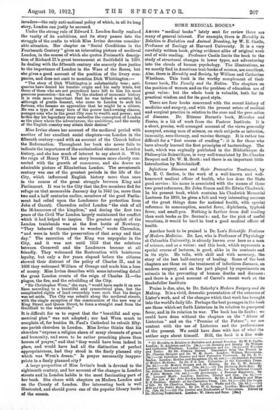LONDON.*
MISS DOUGLAS IRVINE has essayed the task of writing a history of London in less than four hundred pages, and she has therefore been compelled to select some special aspects of so wide and fruitful a subject. Her book is a piece of sound and careful work ; it is vigorous and interesting, and its numerous illustrations of social life at various periods will commend it to many readers.
Of the early history of London Miss Irvine has little to say. She gives, with a few comments, the leading dates in London history before the Norman conquest, but she does not deal with the problems which puzzle the historians of Alfred's reign. Limitations of space and the general character of her work supply good reasons for the absence of such discussions, but it might have been possible to indicate more clearly the essential fact of pre-Norman London history. Between the reign of Alfred and the reign of Edward the Confessor London took the place of Winchester as the real capital of England. In the earlier centuries of Anglo-Saxon England, while Northumbria and Mercia and Wessex were contending for the overlordship of England, the possession of London and of the mouth of the Thames was not a matter of supreme importance, but when England became, in any sense, a united country, and especially when its very existence came to be menaced by the Danish in- vasions, geographical position gave the City of London a great opportunity, of which the citizens did not fail to avail themselves. It is possible that Alfred himself only partially understood its importance, but the Danes were under no misapprehension on the subject, and a comparison of their raids while London was in their possession with those which took place after its recovery by the English affords a signifi- cant comment upon the importance of the City. It was, how- ever, during the second series of Danish invasions, when King Swegen and his son Canute menaced the tottering throne of Ethelred the Unready, that London came to realize its great destiny. At more than one critical moment London alone stood out against the enemy, and Englishmen in their extremity learned to look to London for leadership and guidance. Thus the City of London became the centre of English feeling and the real capital of the country. Its position was recognized by Edward the Confessor when he built his palace at Westminster, and its power of resistance impressed the Conqueror so much that he withdrew from Southwark without attempting to cross the Thames in the face of the opposition of the Londoners.
With the instinct for recognizing the facts of a situation, which marked the City of London throughout its early history, the citizens submitted peacefully to William a month or two later, and they remained loyal to him and to the other Norman kings. In the days of Stephen's weakness the Londoners were tempted by the ambition (learned from towns on the Continent) of placing themselves outside the national organization by obtaining the rights of a commune. A better fate—that of leading the English nation—was in store for London, and it was fortunate that the intervention of a great feudal baron prevented it from making full use of the oppor- tunity of the anarchy. This same ambition was partly responsible for the part taken by the Londoners in resisting John before Magna Carta, but after John's death it led the citizens to prolong unduly their support of the French
• History of London. By Helen Douglas Irvine. London : Constable and Co. [10s. 6d. net.1
invaders—the only anti-national policy of which, in all its long story, London can justly be accused.
Under the strong rule of Edward I. London finally realized the vanity of its ambitions, and its story passes into the struggle of the crafts to which Miss Irvine devotes consider- able attention. Her chapter on " Social Conditions in the Fourteenth Century" gives an interesting picture of medieval London, in the course of which she quotes Froissart's descrip- tion of Richard IL's great tournament at Smithfield in 1390.
In dealing with the fifteenth century she scarcely does justice to the importance of London in the Wars of the Roses, but she gives a good account of the position of the livery com- panies, and does not omit to mention Dick Whittington :—
" The story of Dick Whittington is substantially true ; anti- quaries have denied his humble origin and his early trials, but those of them who are not prejudiced have left to him his most precious possession—his cat. To the student of economic history it is even more important that he was indeed a country lad, although of gentle descent, who came to London to seek his fortune, who became an apprentice that he might be a citizen. He was a type of many born of the poorer land-owning classes, younger eons who in the great City rose to wealth and power; and to this day his legendary story embodies the conception of London as the place where the adventurous, the ambitious, and the needy of the English country may attain their desires."
Miss Irvine closes her account of the medieval period with another of her excellent social chapters—on London in the
fifteenth century—and with an account of the Church before the Reformation. Throughout her book she never fails to indicate the importance of the ecclesiastical element in London history, and she has much of interest to say about it. With the reign of Henry VII. her story becomes more closely con- nected with the growth of commerce, and she draws an
admirable picture of Elizabethan London. The seventeenth century was one of the greatest periods in the life of the City, which influenced English history more than once in the course of the great struggle between King and Parliament. It was to the City that the five members fled for refuge on that memorable January day in 1642 (as, more than two and a half centuries earlier, members of the good Parlia- ment had relied upon the Londoners for protection from John of Gaunt). Clarendon called London " the sink of all the ill-humours of the kingdom," and during the first two years of the Civil War London largely maintained the conflict which it had helped to inspire. The greatest exploit of the London trainbands was at the first battle of Newbury. "They behaved themselves to wonder," wrote Clarendon, " and were in truth the preservation of that army and that day." The execution of the King was unpopular in the City, and it was not until 1653 that the relations between Cromwell and the Londoners became at all friendly. They welcomed the Restoration with boisterous loyalty, but only a few years elapsed before the citizens showed their distrust of the policy of Charles II., and in 1688 they welcomed William of Orange and made him a loan of money. Miss Irvine describes with some interesting detail the great London events of the reign of Charles II.—the plague, the fire, and the rebuilding of the City.
." Sir Christopher Wren," she says, "would have made it on new lines according to a beautiful and symmetrical plan, but the complicated rights of land ownership were such that his design was set aside. The City was rebuilt along the medieval streets, with the single exception of the construction of the new way of King Street and Queen Street, to form a straight road from the Guildhall to the waterside."
It is difficult for us to regret that the " beautiful and sym- metrical plan" was not adopted ; nor had Wren much to complain of, for besides St. Paul's Cathedral he rebuilt fifty- one parish churches in London. Miss Irvine thinks that his churches "express a religion shorn of many elements of grace and humanity, and seem to be rather preaching places than houses of prayer," and that "they would have been indeed in place, and would have had all the distinction of perfect appropriateness, had they stood in the finely planned city
which was Wren's dream." Is prayer necessarily inappro- priate in a finely planned city P
A large proportion of Miss Irvine's book is devoted to the eighteenth century. and her account of the changes in London streets and in London habits is the most fascinating part of
her book. She closes with chapters on Modern London and on the County of London. Her interesting book is well illustrated, and should prove one of the popular library books of the season.



































 Previous page
Previous page